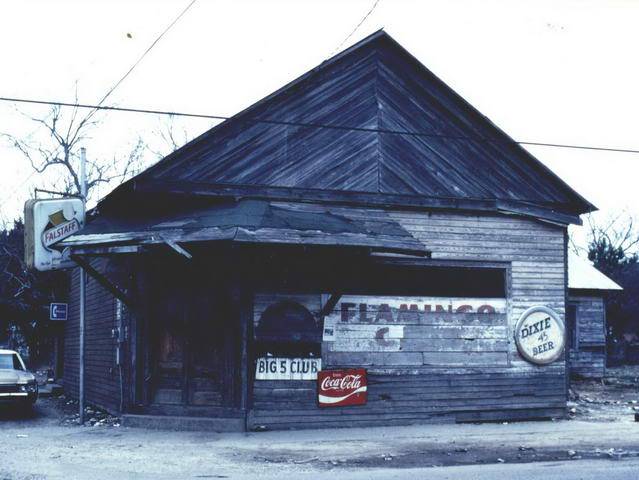Sycamore Street Historic District
 The 'Big 5 Club' on Sycamore
The 'Big 5 Club' on SycamoreNational Register ID: 80002242
Area Of Significance: Black Architecture
Architectural Styles: Early Commercial, Bungalow/Craftsman
Period Of Significance: 1875-1899, 1900-1924, 1925-1949
Date Listed: 11/25/1980
Location: Zone 16, E 274580, N 3355140
Verbal Boundary Description: The Sycamore Street Historic District is a rectangular-shaped area comprising approximately three acres. District boundaries correspond with the boundaries outlined on the city plat map.
Description
The Sycamore Street Historic District contains two commercial buildings and eight residences lining the north side of Sycamore Street east and west of the Old Spanish Trail which runs north to south. The two commercial buildings are located on the east and west corners of St. Francis Street, another cross street east of the Old Spanish Trail. The first block of Sycamore above St. Francis contains, in addition to the commercial building on the corner, only two residences, both frame Bungalow- style cottages, one located approximately in the middle of the block and the other at the corner of Sycamore and the Old Spanish Trail. Lots between these two houses are wooded. West of the Old Spanish Trail the district becomes more densely settled and contains six residences representing a variety of vernacular types a shotgun cottage, a Creole cottage, two Bungalow-style cottages, a Georgian-plan cottage with Queen Anne- and Colonial Revival-style details, and a Georgiaa-plan cottage with three front doors providing access to the gallery. All buildings are either one or one-and-a-half stories high and of frame construction. The area west of the district has been taken over by new residential development, and the area south by urban-renewal project housing. These areas have been excluded for those reasons. All buildings are either of primary or contributing importance; there are no intrusions.
Significance
Important to the study of black history in Bay St. Louis, the Sycamore Street Historic District also contains valuable architectural resources from ca. 1860 through the 1920s. The district is part of what remains of a small black settlement which once extended east, north, and west of the present district boundaries. Although there were enough black families in this area of Bay St. Louis in 1906 to construct a two-story school (building no longer extant), one block north of the present district on St. Francis Street, the area west of Old Spanish Trail was not fully developed as a black community until the 1920s.
Reflective of this development, the district contains a number of Bungalow-style houses, along with two houses which remain from earlier estates. One of these, located at 531 Sycamore Street, is a vernacular house type relatively rare in Mis- sissippi. Showing French influence in its multiple entrances, this five-bay cottage contains doors in each of its middle bays which provide access to an undercut gallery, and is the only example of its type in Bay St. Louis. The house at 523 Sycamore Street, which dates ca. 1895, combines features of the Colonial Revival sytle, such as a louvered gable window articulated in a Palladian motif and central entrance with side lights, with features of the Queen Anne style, polygonal bays and angled window brackets. Another important architectural component of the district is the front-gabled commercial building on the corner of St. Frances and Sycamore streets. Built ca. 1910 it utilized diagonal boarding in its pediment and is a good example of turn-of-the-century vernacular building. Added to an earlier house, it was probably the first large store to be constructed in the neighborhood and illustrates the close proximity of the shopkeeper's residence to his business. Although black families lived in nearby residences, an Italian family, the Benignos, owned this store and one located in the Washington Street Historic District and lived in the attached residences.
(Details and text copied from National Register nomination form)